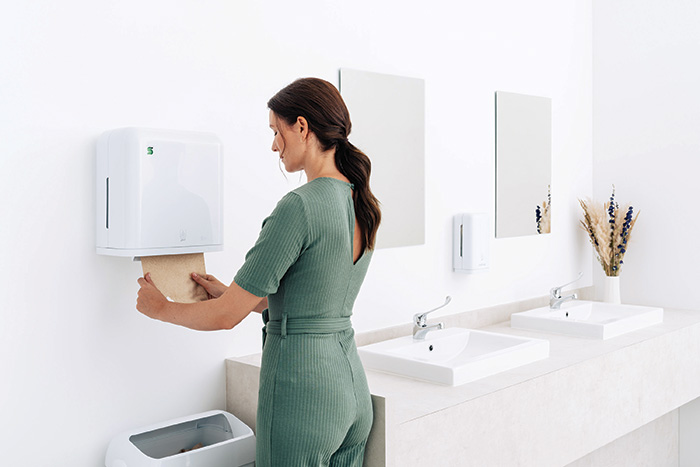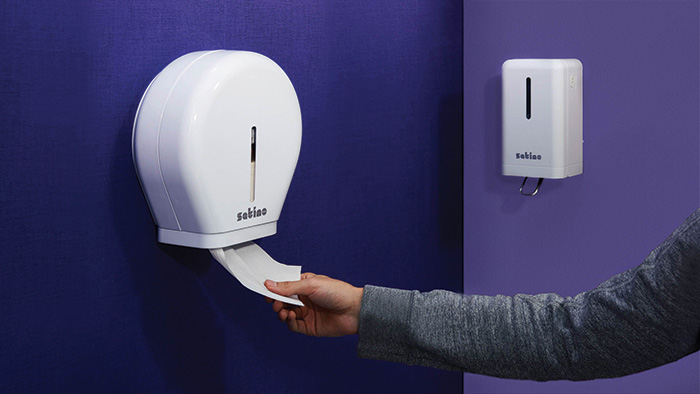Prioritising Sustainability: Beyond The Green

The UK’s sustainability consciousness is continuously growing, and it is consumers’ needs that are helping to drive change within the cleaning and hygiene sector, as they are increasingly demanding more sustainable products and services. Being sustainable can therefore give you a competitive edge as a business.
A 2019 survey of UK football fans found that 86% of those surveyed agreed Premier League football grounds should remove single‑use plastics. Supporting this, a 2021 survey by The FA found that 90% of grassroots football clubs in the UK identified cleaning and disinfection as a top priority for their grounds.
The washroom is often an overlooked area for facilities managers trying to improve sustainability initiatives. However, making eco‑friendly decisions in these areas can significantly impact large venues and stadiums, offering a prime opportunity to promote sustainable practices with guests.
How To Score Big On Eco‑Friendliness

One of the easiest changes large venues and stadiums can make to hit their ESG goals is by picking more sustainable products, including switching to hygiene papers made from alternative or recycled fibres.
In recent years, the hygiene industry has made huge progress with alternative fibre innovations. From natural fibres to utilising untapped waste streams such as cardboard from delivery packages, the market options are growing exponentially.
Innovations from manufacturers mean processing post‑consumer cardboard into usable hygiene paper can reduce the environmental footprint of your hygiene papers by up to a huge 70%.
According to the Environmental Paper Network, a global coalition advocating for sustainable paper practices, recycling paper for tissue production also boasts a dramatically lower environmental footprint. The process requires less energy, generates less wastewater and other waste products, and crucially, emits a third of the greenhouse gases compared to using virgin wood pulp. When it comes to the sustainability strategy for a venue, the impact a change like this can have is invaluable.
Recyclable paper packaging for products is becoming more common too, which further adds to the circularity of your business’ hygiene strategy.
Unbleached Options Deliver A Cleaner Impact

Another easy hygiene paper switch with a big impact is changing to a ‘bleach‑free’ product. Most traditional hygiene papers use a chlorine bleach process to produce the white papers consumers are familiar with. However, in these products, the fibres need to be washed more thoroughly, using much more water than their unbleached counterparts.
How To Control Waste In Stadiums And Venues

Touch‑free technology is a valuable asset to the washroom and beyond, as it boasts multiple benefits.
Whether it’s touch‑free taps that automatically turn off to reduce water waste or paper dispensers that dispense only one paper towel at a time, touch‑free technology not only helps reduce the spread of infection but also the reduction of waste. These devices also require fewer refills than manual alternatives, saving time for cleaning staff, and ultimately saving money, as well as the environmental benefits.
Encouraging Wider Sustainable Change In Stadiums

With passionate, and often international visitors, stadiums hold immense potential to influence. Stadiums can leverage this influence to set a positive example for other large venues. Implementing recycling programmes, utilising recycled and recyclable materials, and eliminating single‑use plastics is becoming standard sustainability practice in stadiums. Extending these measures to the washroom creates a cohesive sustainable approach across the entire facility.
This commitment to sustainability goes beyond just meeting environmental targets. By prioritising eco‑friendly practices, stadiums send a powerful message to fans, encouraging them to adopt similar practices in their own lives. This ripple effect can then lead to a significant positive impact on a global scale.
Integrating sustainability into washroom practices is an achievable goal. By implementing the solutions outlined above, stadiums can significantly reduce their environmental footprint and promote a culture of sustainability. Remember, every fan who experiences a sustainable washroom becomes a potential advocate for change, thus making the beautiful game even greener.
Click the article to enlarge it.












































